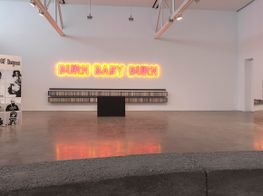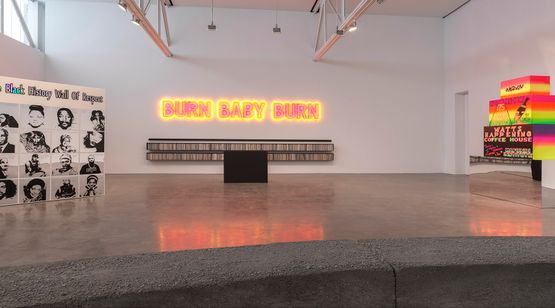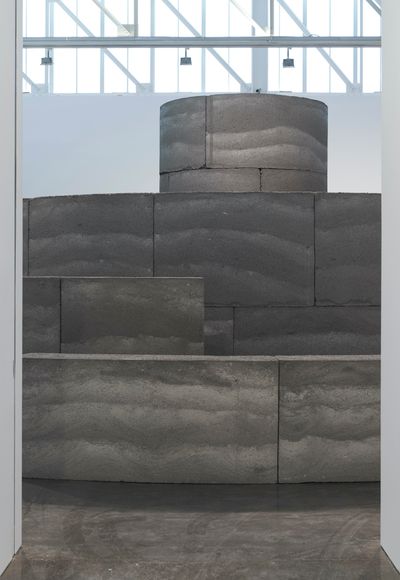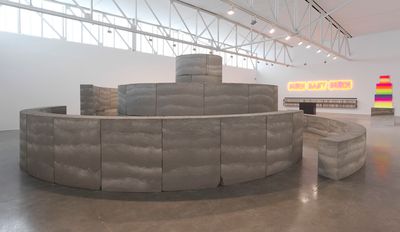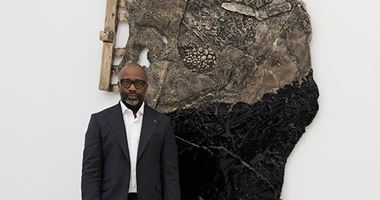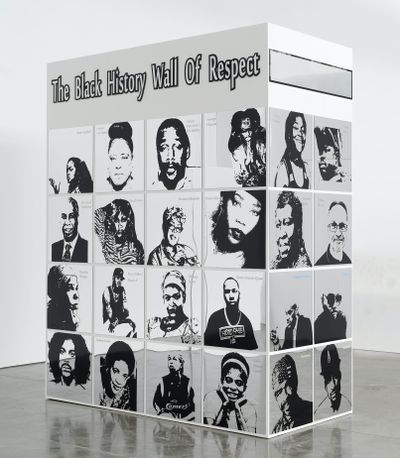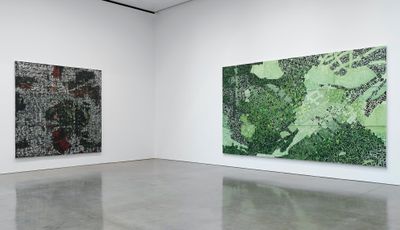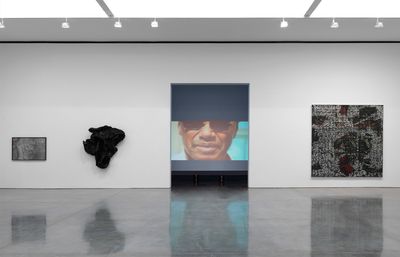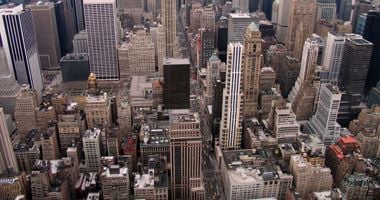Gagosian's Antwaun Sargent Celebrates Community, Resists Erasure
Curated by Gagosian's newest director Antwaun Sargent, Social Works (24 June–13 August 2021) demonstrates the creative ways that artists respond to persistent racial, economic, and sociopolitical exclusion, and rise to the challenge of self and community empowerment.
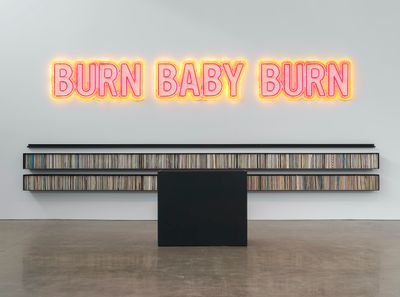
Theaster Gates, A Song for Frankie (2017–2021). 5,000 records, DJ booth, and record player. Dimensions variable. Exhibition view: Social Works, Gagosian, New York (24 June–13 August 2021). © Theaster Gates. Courtesy Gagosian. Photo: Dror Baldinger.
Spread across the entirety of the 555 West 24th Street gallery space in New York, the show features works by 12 artists that run the gamut from paintings to multimedia installations.
Up-and-coming talents Zalika Azim, Allana Clarke, Kenturah Davis, Christie Neptune, and Alexandria Smith—all former fellows of participating artist Titus Kaphar's New Haven-based nonprofit organisation NXTHVN—are highlighted alongside established heavyweights David Adjaye, Theaster Gates, Linda Goode Bryant, Lauren Halsey, Titus Kaphar, Rick Lowe, and Carrie Mae Weems.
While Bryant, in addition to starting the seminal Just Above Midtown gallery space in 1974, and Halsey have founded organisations to address critical food shortages in New York City and Los Angeles (Project EATS and Summaeverythang, respectively), other participating artists have utilised art as a means to provide a platform for emerging voices as well as to create dialogues about topics such as gentrification, revitalisation, and equity.
Asaase (2021), architect David Adjaye's largest installation to date, is inspired by domestic sites in West Africa erected hundreds of years ago, including the Tiébélé royal complex in Burkina Faso and the walled city of Agadez in Niger. Stacked curved blocks, each formed from rammed earth, are arranged into a conical formation.
Harkening back to ancestral homes free from the influence of Eurocentrism, the labyrinthine pathway, whose title comes from the Twi word for 'earth', is intended to lure visitors in, invoking a conceptual journey towards spaces that Black families historically inhabited.
The contemplative austerity of Adjaye's environment is thoughtfully counterbalanced by works situated at the opposite end of the room. Pulsating dance music emanates from Theaster Gates's installation A Song for Frankie (2017–2021), which pays tribute to DJ Frankie Knuckles, a seminal figure within the 1980s Black and queer house music scene.
The musician's personal archive of vinyl records, which number in the thousands, are arranged onto two long horizontal shelves that take on a physical monumentality. In front of the installation, a DJ spins records at a booth: a lively commemoration of Knuckles's pioneering contributions towards a once underground genre that has gone on to have a lasting influence on popular music.
Gates's musical tribute resides beneath a large neon on the wall that reads: 'Burn Baby Burn'. Though the phrase was originally coined by the R&B radio deejay Magnificent Montague, it became a rallying cry during the 1965 Watts Rebellion triggered by the abuse of a 21-year-old man named Marquette Frye by white policemen.
When considering the ongoing police brutality against Black people in the United States, and the wave of global protests for Black Lives Matter ignited by the murder of George Floyd last year, the neon words, though vibrant in appearance, remind viewers of how little progress has been made in the five decades since Marquette Frye's abuse.
Flanking Gates's installation is black history wall of respect (II) and watts happening (both 2021), two sculptures by Lauren Halsey. The former places the portraits of figures such as Octavia E. Butler, Lauryn Hill, and Bootsy Collins on mirrored square panels, bringing to mind the album covers in Gates's nearby installation.
While rightfully celebratory at times, Sargent's curatorial endeavour does not shy away from confronting centuries of erasure and violence that Black men and women have been forced to endure.
Halsey's admiration for her community—its cultural icons and neighbourhoods—is equally pronounced in a separate room dedicated to the artist's totemic structures, which transfer the visual lexicon of storefronts in South Central, where her family has resided for generations, into a kaleidoscopic display that taps into the ingenuity of a society that frequently finds itself under the threat of gentrification. Clustered together, Halsey's sculptures become new landmarks, monumentalising the small businesses that lend vibrancy to neighbourhoods such as Los Angeles's Crenshaw District.
While rightfully celebratory at times, Sargent's curatorial endeavour does not shy away from confronting centuries of erasure and violence that Black men and women have been forced to endure.
The history of violence is further accentuated by a suite of paintings by MacArthur Fellow Rick Lowe in an adjacent room, all stemming from a recent project created on the hundredth anniversary of the 1921 Tulsa Race Massacre. Titled 'Black Wall Street Journey' (2021), map-like images refer to Oklahoma's Greenwood District, a neighbourhood that had been referred to as 'Black Wall Street' due to its affluence, and the lives and homes that were decimated by a white mob unwilling to accept Black prosperity.
Lowes's canvases layer cut paper—including fake hundred-dollar bills—to allude to the ways in which race-driven violence is almost always intertwined with the systematic plundering of wealth.
Marked with frenzied streaks of black and green paint, the canvases stay true to Lowes's trademark style of abstraction. While the artist has long been interested in recreating the patterns of domino tiles in his work, the interlocking grids and lines come together within these new works appear like aerial views of razed cityscapes.
Across from Lowe's paintings is Christie Neptune's three-channel video installation Constructs and Context Relativity – Performance II (2021). Though understated in its presentation across old television screens, the work, defined by an original script that is as striking as the beautifully interwoven cinematography, feels like an unofficial manifesto for Social Works as a whole.
Speaking poetically to the formation of subjective experience, the sequence, which runs just over 12 minutes, was shot in various sites around New York City, over Zoom and also on Super 8mm film, and features the artist as a primary subject whose bodily movements and narrated thoughts explore the tension between the self and the external world.
In one particular segment, an actor repeatedly states, 'We used to be in such close community.' The sentence is an urgent reminder: a kinder tomorrow is possible if only we could pursue it together. —[O]


